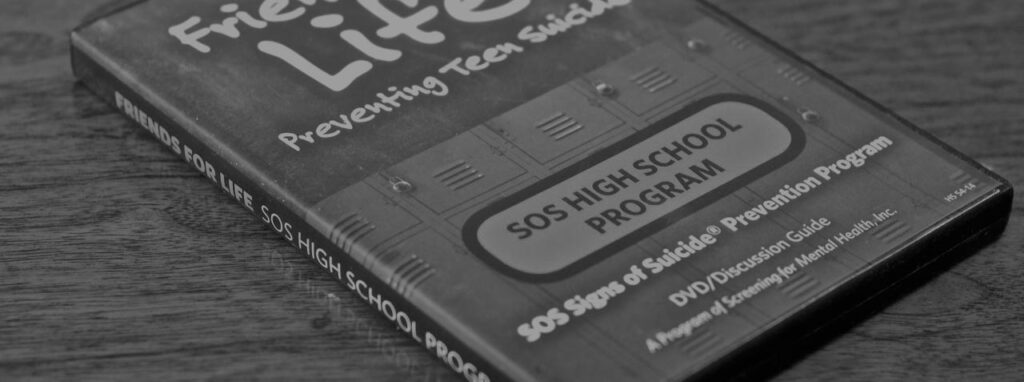 Screening for Mental Health, Inc.
×
Screening for Mental Health, Inc.
×

PREVENTION & EDUCATION
SOS Signs of Suicide is a universal prevention program created by Screening for Mental Health, the organization that also established National Depression Screening Day. The program addresses the urgent need for youth suicide prevention through a two-pronged approach that educates students about suicide and mental health while screening for depression and other risk factors.
Youth suicide represents a critical public health crisis in the United States. According to the Centers for Disease Control and Prevention, suicide is the second leading cause of death among individuals aged 10 to 24. Many young people experiencing suicidal thoughts never receive help due to stigma, lack of awareness about mental health resources, or inability to recognize warning signs in themselves or their peers.
The SOS program directly addresses these barriers by creating school environments where mental health discussions are normalized, students learn to recognize warning signs, and clear pathways exist for accessing help. This comprehensive approach has made SOS one of the most effective school-based suicide prevention programs available.
Educational Curriculum forms the foundation of the SOS program. Students participate in guided instruction teaching them about suicide, depression, and other mental health conditions. The curriculum emphasizes that suicide is preventable and that mental health conditions are treatable, providing hope and actionable information to young people who may be struggling.
A key educational component is the ACT acronym, which teaches students how to respond when they or someone they know shows warning signs of suicide. ACT stands for Acknowledge, Care, and Tell. Students learn to acknowledge signs of suicide and take them seriously, show care and support to individuals in distress, and tell a responsible adult who can provide help. This simple framework empowers students to take potentially life-saving action.
Video presentations engage students with realistic scenarios demonstrating warning signs and appropriate responses. These videos feature age-appropriate characters facing mental health challenges, helping students recognize similar situations in their own lives. Discussion following video presentations allows students to process information, ask questions, and practice identifying warning signs.
Mental Health Screening represents the second major component of the SOS program. Students complete brief, validated screening instruments assessing depression and other suicide risk factors. These confidential screenings identify students who may need additional support or professional mental health services.
Screening occurs within the educational context, typically immediately following curriculum delivery when students have just learned about mental health and available resources. This timing increases likelihood that students will respond honestly to screening questions and follow through with recommended next steps.
Follow-Up Protocols ensure identified students receive appropriate care. School personnel trained in SOS implementation review screening results and contact students showing elevated risk. These follow-up procedures include immediate assessment by school counselors or mental health professionals, parent or guardian notification when appropriate, and referrals to community mental health services when needed.
The program provides clear protocols for handling emergencies, including situations where students express immediate suicidal intent. These crisis response procedures ensure student safety while connecting families with appropriate professional support.
The SOS Signs of Suicide program has undergone extensive research evaluation, demonstrating significant positive outcomes. Multiple studies published in peer-reviewed journals have documented the program’s effectiveness in reducing suicide attempts and increasing adaptive attitudes toward depression and suicide.
Research shows that students participating in SOS demonstrate improved knowledge about depression and suicide, increased likelihood of seeking help for themselves or others, and reduced suicide attempts compared to students who do not receive the program. These outcomes persist over time, indicating lasting impact on student mental health and help-seeking behaviors.
The program has received recognition from the Substance Abuse and Mental Health Services Administration (SAMHSA) as an evidence-based practice. This designation reflects rigorous evaluation demonstrating program effectiveness and adherence to quality standards in prevention programming.
PROMOTIONS & SUPPORT
Schools implementing the SOS program receive comprehensive implementation support including curricula materials, screening instruments, training for school personnel, and ongoing technical assistance. The program integrates into existing health education, advisory periods, or dedicated mental health instruction time.
Successful implementation requires buy-in from school leadership, support from school counselors and mental health staff, and engagement with parents and community mental health providers. Schools typically dedicate one to two class periods for program delivery, making SOS relatively efficient compared to more time-intensive interventions.
Teacher and Staff Training prepares educators to deliver the curriculum effectively and respond appropriately to student disclosures. Training addresses mental health basics, suicide warning signs, gatekeeper skills, and school protocols for supporting at-risk students. Many schools designate specific mental health professionals or trained counselors to handle screening follow-up and crisis response.
Parent Communication represents an important implementation component. Schools inform parents about the program before implementation, explaining educational content, screening procedures, and follow-up protocols. This transparency builds trust and ensures families understand how schools support student mental health.
The SOS program has been adapted for diverse student populations, with versions available for different age groups and cultural contexts. Spanish-language materials ensure accessibility for Hispanic and Latino students and families. Program developers have worked to ensure cultural sensitivity and relevance across varied school communities.
Adaptations maintain core program components while adjusting examples, language, and implementation approaches to fit specific school contexts. This flexibility allows schools serving diverse populations to implement SOS effectively while maintaining program fidelity.

RISK MANAGEMENT & LIABILITY
While primarily school-based, the SOS approach has informed suicide prevention efforts in other youth-serving settings including juvenile justice facilities, residential treatment programs, and community organizations. The program’s combination of education, screening, and clear intervention protocols provides a model for comprehensive suicide prevention across contexts where young people gather.
The SOS Signs of Suicide program demonstrates that evidence-based, comprehensive approaches to youth suicide prevention can save lives. By educating students about mental health, teaching them to recognize and respond to warning signs, screening for risk factors, and ensuring clear pathways to professional help, SOS creates school environments where struggling students can access the support they need.
As youth suicide rates remain elevated, programs like SOS represent essential tools for protecting young people and building healthier communities. Through continued implementation in schools nationwide, the SOS program will keep saving lives while fostering mental health awareness and reducing stigma among the next generation.

FEATURED PROGRAMS
SOS Second Act is designed to build resiliency in young adults. In addition to reviewing the signs and symptoms of depression and suicidality, students are prompted to discuss substance abuse and other risky behaviors. Students are provided with a solid foundation on health care basics, health insurance, and self-care tips on seeking mental health treatment in the “real world.”
The Online Parent Brief Screen for Adolescent Depression (BSAD) allows parents to assess their child for suicide or depression risk factors. After parents complete a series of questions online, the screening provides results, local referral options (determined by each school), and relevant, educational information.